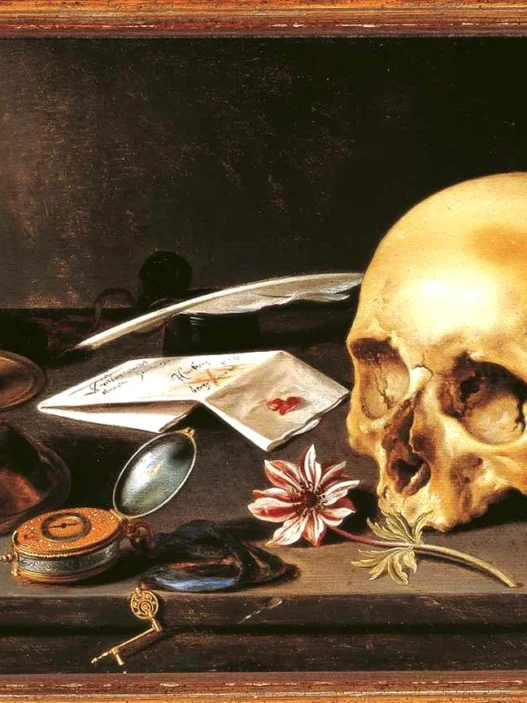Poland’s Symbolist painter, Jacek Malczewski, created Vicious Circle (1895–1897), a complex work blending personal introspection with social and artistic commentary. The Symbolism of Jacek Malczewski offers a profound exploration of the cyclical nature of life, creativity, and moral conflict.
For those interested in polish folklore and stories, Mediating the Otherworld in Polish Folklore explores the subject in more detail.
The composition serves as a powerful visual representation of the eternal struggle between personal desires, societal expectations, and the burdens of artistic creation. It reflects Malczewski’s deep engagement with the darker, more existential aspects of human experience.
Let’s break down the painting into its key elements.
The Boy on the Ladder
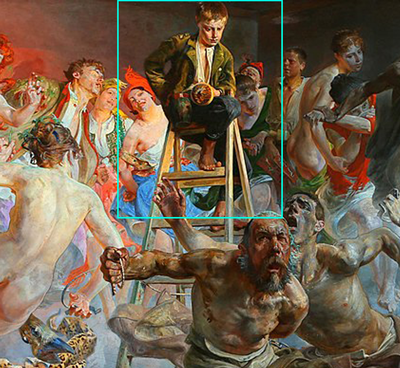
At the centre of the painting sits a boy atop a wooden ladder, barefoot and holding a large brush. His posture suggests contemplation, as if he is both observing and partaking in the swirling world below. This figure can be interpreted as a representation of the artist himself, something that recurs throughout the painting.
-
The ladder divides the painting into two distinct halves,
-
Symbolic boundary between two opposing worlds
-
The boy’s position atop the ladder suggests a sense of distance, perhaps signifying the artist’s detachment from the chaos below
The Left Side: Light, Joy, and Vitality
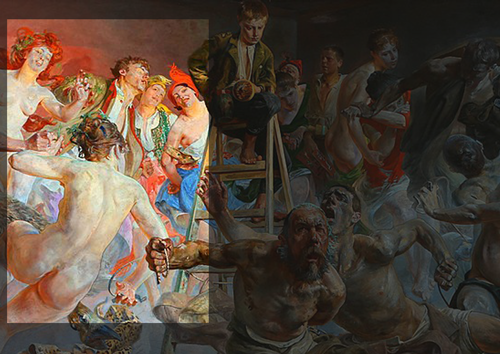
On the left, the composition is filled with mythological and folkloric characters, primarily Bacchantes (female followers of Bacchus, the god of wine and revelry), a faun, and a peasant couple in traditional costumes. These figures exude life, energy, and sensuality as they appear to dance in an uninhibited celebration of the human spirit.
- Warm colours such as golden yellows, reds, and oranges gives this side an almost radiant quality.
- The light bathes the figures in a sense of purity and freedom, contrasting with the darker, more oppressive tone of the right side.
- This vibrant section may symbolise the desires and passions of the human condition.
The Right Side: Darkness, Suffering, and Conflict
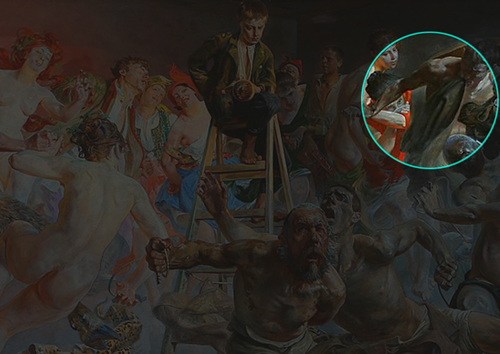
In contrast, the right side of the painting represents despair, suffering, and moral conflict. The figures here are dark and contorted, depicted in agony or anguish. The scene is filled with images of phantoms and exiles, some shackled and others twisted in pain, symbolising the harsh consequences of excess, temptation, and moral failure.
- The figures are draped in heavy dark robes, signifying oppression and suffering.
- Trapped in an eternal cycle of pain, highlighting the destructive side of human nature and the darker aspects of life.
- Artist’s inner conflict, Dark side of creativity and the artist’s battle with his own demons.
The Symbolism of the Mirror and the Serpent
Let’s take another look at the boy on the ladder holding a mirror, which reflects the image of a young woman. This mirror can be seen as a symbol of self-reflection, introspection, and the constant need for the artist to confront his own identity, choices, and actions.
The Allegory of the Vicious Cycle
The title Vicious Circle suggests a never-ending cycle, one that is both destructive and inescapable. This recurring loop can be seen countless times through the symbolism of Jacek Malczewski.
- The ladder, with the boy perched atop it, is a reminder that the artist is always caught in this cycle, torn between creation and destruction, pleasure and pain, hope and despair.
- The boy’s brush, poised to add to this continuous cycle, highlights the artist’s role in this perpetual creation and destruction.
Malczewski’s Symbolism and the Interplay of Light and Dark
The stark contrast between light and dark is one of the most striking features of Vicious Circle. The interplay between these two extremes underscores the painting’s central themes: the tension between innocence and corruption, pleasure and suffering, creation and destruction.
- The use of light to symbolise vitality, joy, and moral clarity on the left side stands in opposition to the shadowy, bleak darkness of the right side, which represents pain, despair, and moral conflict.
- This duality is not merely aesthetic.
- Symbolic commentary on the complexities of the human condition, the struggles between good and evil, and the cyclical nature of these forces.
The Role of Society and Political Allegory
The painting also contains subtle political and social commentary. The figures in traditional and revolutionary dress, like the woman in the red Phrygian cap (likely a symbol of Marianne, representing the French Republic), evoke themes of revolution, national identity, and societal change.
- The image of the fallen angel, with its connection to rebellion and defiance
- Malczewski, living in a time of political and cultural upheaval in Poland, may be using the painting to reflect the struggles of his own society, where ideals of freedom and identity clash with the realities of oppression and suffering.
Echoes of Symbolism: Malczewski, Redon, and Moreau
The Symbolism of Jacek Malczewski is steeped in Polish Romanticism, where myth, patriotism, and metaphysical introspection entwine in a dreamlike visual language.
His figures often embody Poland’s soul—martyrs, muses, and spectral allegories wandering between reality and the sacred.
This metaphysical quality finds kinship with Odilon Redon, whose pastel visions veer into the fantastical and the subconscious. Both artists explore inner worlds, but where Redon dissolves form into hazy reveries, Malczewski anchors his symbols in national identity and classical structure.
Similarly, Gustave Moreau’s ornate, jewel-toned mythologies share Malczewski’s fascination with biblical and mythological figures as conduits for inner truth. All three painters build a visual language where symbolism becomes a vehicle for the ineffable—faith, despair, hope, and the longing for transcendence.
















